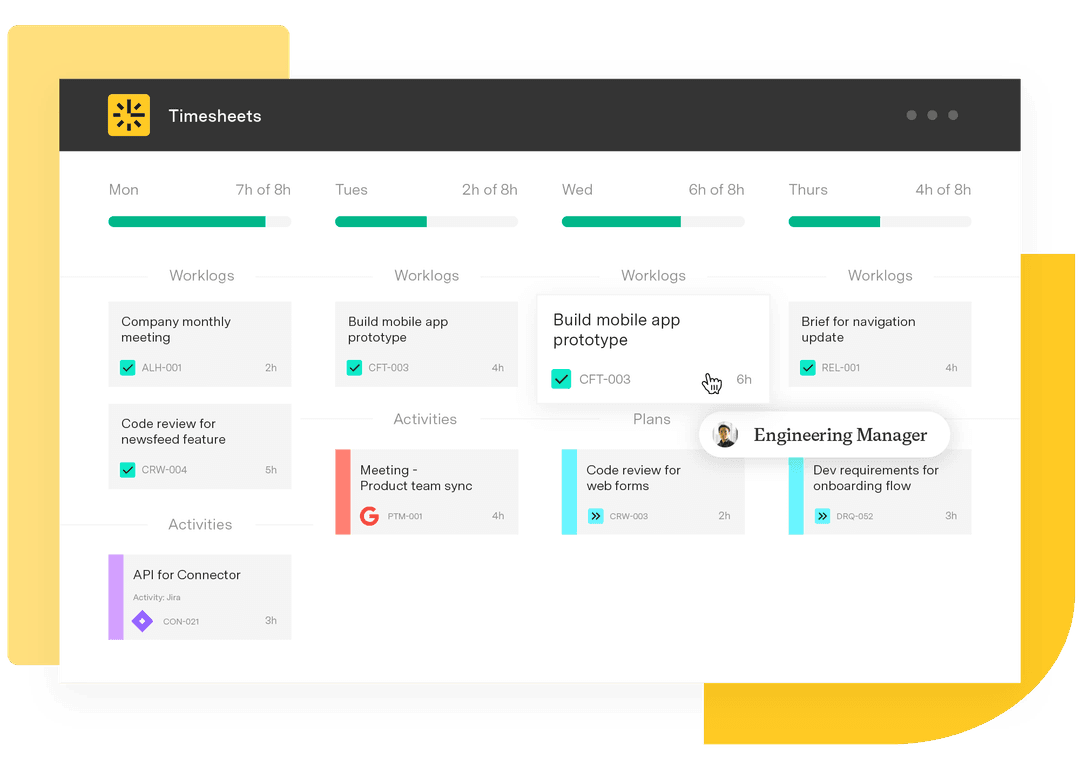A guide to business requirements document templates
Tempo Team
A business requirements document template is your blueprint for success. A comprehensive BRD establishes expectations to minimize confusion and set the stage for a smoother, more successful project. It keeps teams organized and aligned by clearly outlining business goals, stakeholder analyses, timelines, and more.
Here, we’ll explain what a BRD is, define the essential elements of a BRD template, and show you how it can enhance project planning and execution.
What is a business requirements document (BRD)?
A business requirements document is the foundation of any successful project. It outlines the business objectives before coding, designing, or development begins. In other words, the BRD defines the “what” behind the work – not the “how.”
This high-level documentation tool fulfills the following functions:
Define the project scope and business needs
Align the goals of key stakeholders
Set expectations for the development team and the project manager
Identify any constraints or dependencies
Create a shared understanding of success
A consistent, well-structured format streamlines this process. Most teams use a standardized business requirements document template that captures everything from the executive summary to milestones, helping them avoid miscommunication and missed deliverables.
Business requirements document template
A BRD aligns teams around shared goals and keeps the project moving forward without constant back-and-forth clarification. Here’s what a complete BRD template usually includes and why each part matters:
Project overview
The project overview explains why the project exists, what problem it’s trying to solve, and the business context. Think of it as your elevator pitch. A busy CEO should be able to skim it and immediately understand the project’s value.
Business objectives
What are you trying to accomplish? This section should list the business goals the project aims to achieve, such as improving a business process, increasing revenue, reducing costs, or meeting compliance standards. It designates measurable target outcomes and definite timelines.
Stakeholder analysis
The stakeholder analysis identifies key stakeholders and outlines their expectations before work begins. Typical details include:
Name and role
Interest level (high, medium, or low)
Communication preferences
Responsibilities
Requirements summary
The requirements summary is the heart of the document. It establishes the following:
Functional requirements: What the system must do (e.g., features, workflows, actions).
Nonfunctional requirements: How it should perform (e.g., security, reliability, usability).
Prioritization: Categorize tasks into must-have vs. nice-to-have features.
Supporting visuals or diagrams: Illustrate user flows or business processes.
A thorough and specific requirements summary leaves less room for confusion later on, especially during design and development.
If you’re building a software project, consider using a software requirements specification template, as well. Whereas a BRD focuses on high-level business needs, an SRS digs into the technical side to ensure proper functionality. When both documents work in sync, you can enjoy streamlined planning and execution.
Assumptions and constraints
This section is about managing expectations. It examines underlying assumptions (e.g., “users will already have accounts”) and limitations you might face (e.g., “product must stay within current infrastructure”). Documenting constraints and dependencies here helps you avoid painful surprises later.
Success criteria and KPIs
How will you know the project is working? This section defines metrics and outcomes that signal success. These might include:
Increased user adoption
Faster load times
Higher conversion rates
Fewer customer support requests
These key performance indicators (KPIs) guide decisions during development and give leadership a way to measure ROI.
Timeline and milestones
Projects need structure, and this section lays it out. It should establish the following:
Major milestones and deadlines
Estimated delivery phases
Dependencies between tasks
Integration with project plans or agile roadmaps (if you’re using tools like Jira)
The timeline is a shared reference point for the development team, project manager, and other stakeholders involved in implementation.
Benefits of using a business requirements document template
A business requirements document template is a strategic tool that streamlines project management from day one. Here’s how a structured BRD template enhances team alignment and project clarity:
Ensures consistency: A template standardizes the BRD structure, guaranteeing you address key sections like project scope, functional requirements, and milestones.
Saves time: A template eliminates the need to create documents from scratch, allowing you to focus on requirements and content.
Minimizes errors: A clear structure helps you spot gaps or mistakes, ensuring critical elements get adequate attention.
Improves project planning: BRD templates clarify objectives, success criteria, and key stakeholders, setting a solid foundation for project plans.
Aligns stakeholders: It promotes a shared understanding of expectations and goals for every team member, from business analysts to project managers.
Improves decision-making: A well-organized document aids decision-makers by providing clear insights into business needs and cost-benefit analyses. It converts complex information into digestible summaries for executive reports, helping leadership visualize the path forward.
BRD vs. FRD
The Business Requirements Document (BRD) and the Functional Requirements Document (FRD) are both essential project management tools, but they serve different purposes and cater to distinct audiences.
Business requirements document (BRD)
The BRD outlines the project’s business needs and goals. It focuses on high-level objectives, project scope, and stakeholder expectations.
Purpose: Defines the business goals and requirements for success.
Audience: Targets business stakeholders (e.g., executives, project managers, and product owners).
Content: Covers business objectives, requirements gathering, project scope, and success criteria. It often includes high-level timelines and milestones.
Functional requirements document (FRD)
In contrast, an FRD dives into an initiative’s functional specifications and explains how the solution will work. It translates the business goals from the BRD into specific, actionable features or capabilities that the project must deliver.
Purpose: Defines the solution’s precise functions and features.
Audience: Primarily aimed at the development team, product managers, and designers.
Content: Describes product requirements, system functionality, and technical specifications. It may include diagrams, wireframes, and user interface designs.
Streamlining requirements and planning with Tempo
After you’ve developed a business requirements document template, the real challenge begins: turning plans into successful projects. That’s where Tempo can help. Tempo’s Jira-integrated tools allow project managers to plan, track, and adjust projects on the fly for streamlined execution.
With Strategic Roadmaps, you can visualize timelines and milestones, ensuring everyone stays on track. Meanwhile, Timesheets makes it easy to track progress and team hours, giving you a real-time pulse on the project’s progress.
Don’t just plan; execute with confidence. Try Tempo today and unlock a new level of efficiency for your team.












































